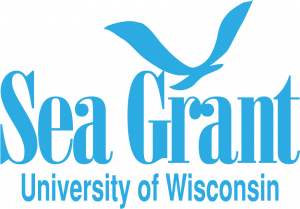The Nearshore Ecosystem
Until recently most management and research efforts in the Laurentian Great Lakes focused on the pelagic zone. But over the past three decades several changes have occurred, including the establishment of dreissenid mussels, the resurgence of nuisance algae (primarily the filamentous green alga, Cladophora), and the population explosion of the invasive round goby (Neogobius melanostomus). These changes have important implications for ecosystem function and structure, including energy flow, nutrient dynamics, and food web structure. From a practical perspective, this presents a challenge to managers, and so one of our goals is to support management through a better understanding and modeling of the nearshore ecosystem. From a basic science perspective, Lake Michigan is an ecosystem-scale experiment in progress, and studying how the system responds to recent perturbations will allow us to address fundamental questions such as: How robust are limnological paradigms and ecosystem models that were developed prior to the invasion of dreissenids? To what extent do nearshore processes affect large-lake functioning?
Specific research efforts include:
- Measuring and modeling the fate of river-borne phosphorus in the nearshore zone.
- Determining the mechanisms that regulate nuisance algal growth and biomass.
- Assessing the effects of dreissenid mussels through mussel removal experiments.
- Constructing the nearshore food web.
Publications:
Bravo, H.R., H. Bootsma, and B. Khazaei. 2019. Fate of phosphorus from a point source in the Lake Michigan nearshore zone. In press. J. Great Lakes Res.
Turschak, B.A., S. Czesny, J.C. Doll, B.K. Grunert, T.O. Höök, J. Janssen, and H.A. Bootsma. 2019. Spatial variation in trophic structure of nearshore fishes in Lake Michigan as it relates to water clarity. Can. J. Fish. Aquat. Sci. 76(3):364-377.
Feiner, Z.A., C. Foley, H.A. Bootsma, S.J. Czesny, J. Janssen, J. Rinchard, and T.O. Höök. 2018. Species identity matters when interpreting trophic markers in aquatic food webs. PLoS One 13(10):e0204767.
Foley, C., M.L. Henebry, A. Happel, H. Bootsma, S. Czesny, J. Janssen, D. Jude, J. Rinchard, and T. Höök. 2017. Patterns of integration of invasive round goby (Neogobius melanostomus) into a nearshore freshwater food web. Food Webs 10:26-38.
Waples, J.T., H.A. Bootsma, and J.V. Klump. 2016. How are coastal benthos fed? Limnol. Oceanogr. Letters 2(1):18-28. doi: 10.1002/lol2.10033.
Tyner, E., H.A. Bootsma, and B. Moraska-Lafrancois. 2015. Dreissenid metabolism and ecosystem-scale effects as revealed by oxygen consumption. J. Great Lakes Res. 41 (Suppl. 3):27-37.
Bootsma, H.A., M.D. Rowe, C.N. Brooks, and H.A. Vanderploeg. 2015. Commentary: The need for model development related to Cladophora and nutrient management in Lake Michigan. J. Great Lakes Res. 41 (Suppl. 3):7-15.
Turschak, B.A., D. Bunnell, S. Czesny, T.O. Höök, J. Janssen, D. Warner, and H.A. Bootsma. 2014. Nearshore energy subsidies support Lake Michigan fishes and invertebrates following major changes in food web structure. Ecology 95(5): 1243-1252.
Auer, M.T., L.M. Tomlinson, S.N. Higgins, S.Y. Malkin, E.T. Howell, and H.A. Bootsma. 2010. Great Lakes Cladophora in the 21st century: same algae, different ecosystem. J. Great Lakes Res. 36:248-255.
Bootsma, H.A., and Q. Liao. 2014. Nutrient cycling by dreissenid mussels: Controlling factors and ecosystem response. Pages 555-574 In: T.F. Nalepa and D.W. Schloesser (eds.), Quagga and zebra mussels: biology, impacts and control (2nd ed.). Taylor and Francis.




